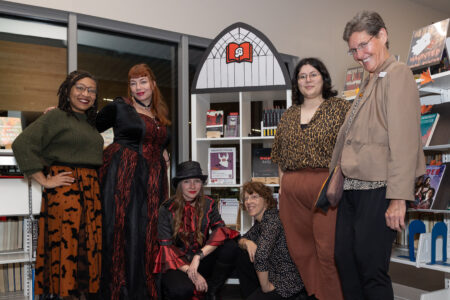‘Bizarre and uncomfortable’: Display at Antique Mall features dolls and statuettes associated with anti-Black imagery next to copy of Hitler’s ‘Mein Kampf’

photo by: Austin Hornbostel/Journal-World
At the Antique Store on Massachusetts Street, these items were on display as of the morning of Thursday, Oct. 5, 2023 — dolls and statues commonly associated with anti-Black imagery next to a copy of the book “Mein Kampf.”
At the Antique Mall on Massachusetts Street, a display case of items for sale as of Thursday morning featured dolls and statuettes commonly associated with anti-Black imagery next to a copy of Adolf Hitler’s “Mein Kampf.”
For Lawrence resident Taj Moses, a Black man, happening across the display while browsing at the mall with a friend earlier this week was a “bizarre and uncomfortable” shock — and in his view, something that didn’t mesh with the ideals of a community associated with the abolitionist John Brown.
“I think that’s part of what caused me to be so stunned in the first place, because I moved to Lawrence for a reason,” Moses told the Journal-World Thursday morning. “I’m gay and Black — this is the only place in Kansas that I felt like I would remotely be just generally more safe, I guess. And considering the history of the city and everything like that, I don’t understand how this is here at all, or how long it’s been here.”

photo by: Austin Hornbostel/Journal-World
Another view of the display is pictured Thursday, Oct. 5, 2023.
• • •
Moses first came across the display on Tuesday. He told the Journal-World he was “very disturbed,” and was initially shocked enough that he wasn’t even sure if he was making a bigger deal out of what he’d seen than he should be.
“I was originally talking to other people because I was like, ‘Am I overreacting to this, or is this really not OK?'” Moses told the Journal-World Thursday morning. “And everybody was like, ‘Yeah, no, there’s nothing that would make that all right.'”
Moses returned the following day to explain to the mall’s staff that the display was “inappropriate and incredibly offensive” and to ask if the mall vetted what was sold and displayed there.

photo by: Austin Hornbostel/Journal-World
A few more statues were placed on a shelf below the other items on display.
Kyle Billings, a manager at the mall, spoke with the Journal-World about the display Thursday morning. Billings said he wasn’t initially aware of the display until Moses and his friend, Anthony Boynton, reached out to him, in part because the displays throughout the store are curated by individual vendors and not by store staff. Billings said he’s been contacted by customers before about other items on display in the store that he wasn’t aware of until they were brought to his attention directly.
In response to their concerns, Billings said the store would be taking “Mein Kampf” out of the display and speaking with the vendor. He declined to share the vendor’s contact information with the Journal-World.
“We leave it broad so that we can take an item-by-item approach to what is acceptable here and what is appropriate in nature,” Billings said.
But as for the other items, which Billings described as “Black Americana” items, he said the store was more hesitant to pull them from shelves. He said that in speaking with other vendors and collectors, there’s a perception that the items are seen as a collectible by “a lot of people in the Black community,” even though some of them might be seen as offensive.
Billings said he doesn’t want such items to turn into a “canceled” part of history, and described how there’s a “slippery slope” in deciding what is and isn’t appropriate. But he also said that he wants to make sure he’s talking to the right people who can help him understand how to take the right steps to avoid leaving items up for sale that are inappropriate while not removing others too hastily, especially when concerns like this are brought to his attention.
For “Mein Kampf,” though, Billings said it was “pretty far over the line and not worth having in here.”
Moses told the Journal-World later on Thursday that while removing the book is a start, it doesn’t address the overall issue of letting vendors display and sell whatever they want unless it’s illegal.
“Lots of violent and harmful imagery and ideology is ‘legal,'” Moses said. “That doesn’t make it acceptable, and if they’re not removing the dolls (and) statues as well, it doesn’t address the issue of it being an inappropriate place to sell such ‘historical memorabilia.'”
Moses said there are other, more appropriate and less public ways to sell items like this if a vendor or store insists on selling them, and that nobody should have to happen upon something like that in a public store — especially in a community like Lawrence.
• • •
Boynton, meanwhile, told the Journal-World that one popular opinion is that items like this should be displayed in a museum or used in a classroom setting with the proper historical context. Boynton is a doctoral candidate in the University of Kansas’ Department of English, where he has studied Black literature and culture with an emphasis on the ways race and gender show up in representations like the figures on display at the Antique Mall.
He said that “Black Americana” items aren’t racist on the whole — but there are certainly some of them that are. For this display in particular, Boynton said the fact that the items were placed next to the autobiographical manifesto of the genocidal Nazi dictator Hitler made it seem less like an accident and more “like it was on purpose.”
“There’s a context of white supremacy that we are very much seeing erupting today,” Boynton told the Journal-World. “What is that objectively supposed to be saying to me? It’s hard for me to not read that as racist; it’s very difficult for me to not read that as racist.”
Boynton added that many perpetrators of racially motivated shootings have quoted Hitler’s text and others like it. He said he thinks society at large “underestimates” what that looks like as it happens in real time.
“It matters that ‘Mein Kampf’ is taken more seriously than the ‘mammy’ archetypal dolls (an enduring racial caricature of Black women as enslaved, docile caretakers to white families),” Boynton added. “There’s a way that anti-Blackness is underestimated in that.”
He said, given the historical context and seeing the items in the display collectively, he thinks that people in Lawrence would be upset that it’s here.
In addition to the other items, the display features a book titled “The Great War on White Slavery.” Written by Clifford G. Roe and published in 1911, it appears to be about human trafficking of white women and girls and fighting against “vices” that are “false to our Teutonic conscience, ideals, history and heritage.”
Moses agreed with Boynton’s sentiment about “Mein Kampf” perhaps being treated differently from the other elements of the display. He said it’s a good example of antisemitism being taken “more seriously” than anti-Black sentiments among non-Black people. Moses wondered why removing Hitler’s book seemed to be a relatively immediate priority, but the dolls and statues are still a “conversation to be had.”
In part, Boynton said that’s because stereotypes have been used to cast hate toward all kinds of people — particularly in film and television, where stereotypes about race and gender have been used both to characterize fictional characters and justify the prejudiced treatment that people received in their real lives.
They’re images — like characterizing Black people as having inhuman or exaggerated features and a greater propensity for violence — that were presented as “science,” he said, as a way to prop up hate crimes like lynching and racial violence.
Boynton said that manifests in modernized examples of the same type of unimposing figure as the mammy caricature — modern spokespeople like “The Pine-Sol Lady,” a Black woman with a similar mothering demeanor.
“We don’t make those connections as often, but those lineages are still there,” Boynton said. “… There are ways that those images and those representations are haunted by that history, and we just can’t deny that. I think we forget how racist the film and media industry was before the civil rights movement.”






